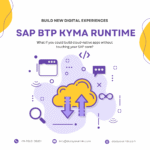Introduction
In every modern enterprise, the flow of information is the pulse that drives decision-making, operational efficiency, and customer satisfaction. Yet many companies struggle with disconnected systems, legacy applications, and inconsistent data flows. Despite significant investments in technology, the promise of a truly connected organization often remains unfulfilled.
Why does this happen? Because integration is not just about having multiple systems—it’s about making sure they work together in a seamless, reliable way. The challenge isn’t the absence of technology; it’s that the technology doesn’t talk to itself.
This is where Dell Boomi comes into play. Dell Boomi is more than just another integration tool; it is a platform designed to knit together the disparate parts of an organization’s IT ecosystem, creating a unified environment where data flows freely, processes run smoothly, and insights become actionable. In this blog, we explore the need for a unified integration strategy, examine how Dell Boomi addresses this challenge, and outline practical ways in which it reshapes the way businesses operate.
The Why: The Need for Seamless Integration
Consider the typical enterprise scenario: a company uses a variety of systems to manage its operations—ERP for finance, CRM for sales, SCM for logistics, and countless specialized applications in between. Each system generates valuable data, yet they often exist in isolation. When data is scattered across platforms, decision-makers are left piecing together insights from multiple sources. This fragmentation not only creates inefficiencies but also leaves gaps in understanding that can lead to missed opportunities and costly errors.
The Cost of Disconnected Systems
- Delayed Decision-Making: When critical information is spread out and hard to access, leaders are forced to rely on outdated reports. Timely decisions become a luxury, not a necessity.
- Inefficiencies Across Departments: Siloed data forces teams to manually reconcile information, wasting time and resources that could be better spent on strategy and innovation.
- Increased Operational Risks: Data discrepancies and errors proliferate when systems do not communicate effectively, increasing the likelihood of compliance issues and operational failures.
- Stifled Growth: Without a clear, unified view of operations, businesses struggle to adapt quickly to market changes, resulting in slower growth and a weakened competitive position.
The essence of modern business is agility—being able to respond quickly to new challenges, opportunities, and market shifts. When systems are not integrated, companies cannot tap into the full potential of their data or leverage technology effectively to drive progress.
The How: Dell Boomi’s Approach to Integration
Dell Boomi is designed to address these challenges head-on by providing a cloud-based Integration Platform as a Service (iPaaS). Unlike traditional integration methods that involve lengthy, complex coding projects, Dell Boomi offers a streamlined, visual interface that makes it easier to connect disparate systems, both on-premise and in the cloud.
A Visual and Flexible Integration Framework
At the core of Dell Boomi is its visual design environment. With a drag-and-drop interface, users can design and deploy integration workflows quickly. This approach not only reduces development time but also minimizes the need for extensive coding expertise. Business users and IT professionals can collaborate more effectively, ensuring that the integration solutions reflect real business needs.
Pre-Built Connectors and API Management
One of Dell Boomi’s standout features is its extensive library of pre-built connectors. These “Snaps” are designed to integrate with popular applications—from ERP and CRM systems to cloud storage and beyond. By leveraging these connectors, companies can reduce the time and complexity of building custom integrations from scratch.
In addition to connectors, Dell Boomi provides robust API management. This allows businesses to expose, manage, and secure their data in a controlled way. The platform supports both REST and SOAP protocols, ensuring that a wide range of systems can communicate effectively.
Real-Time Data Flow and Automation
Dell Boomi excels at facilitating real-time data integration. With its cloud-native architecture, the platform ensures that data moves seamlessly between systems without the delays inherent in traditional batch processing. This real-time connectivity is crucial for decision-making, allowing leaders to act on current information rather than relying on outdated reports.
Automation is another key strength of Dell Boomi. The platform automates routine data transfers and processes, reducing the risk of human error and freeing up valuable time for strategic tasks. By automating repetitive tasks, Dell Boomi helps organizations focus on their core business activities rather than being bogged down by technical hurdles.
Scalability and Adaptability
As businesses grow, their integration needs evolve. Dell Boomi is built to scale, handling increasing data volumes and more complex workflows without a drop in performance. Its cloud-based model means that as your organization expands, Dell Boomi adapts to meet new challenges without requiring a complete overhaul of your integration architecture.
Moreover, Dell Boomi supports a hybrid IT environment, seamlessly bridging on-premise systems with cloud applications. This flexibility is essential for businesses that are in the midst of digital transformation, as it allows them to integrate new technologies without abandoning legacy systems.
The What: Benefits of Using Dell Boomi
Implementing Dell Boomi can have a transformative impact on an organization. Here are some of the tangible benefits:
Enhanced Operational Efficiency
By integrating systems and automating data flows, Dell Boomi helps eliminate redundant processes. This streamlining of operations results in:
- Faster processing times: Real-time data movement means decisions are made on the latest information.
- Reduced manual errors: Automated workflows reduce the risk of human mistakes, ensuring data consistency across the board.
- Optimized resource allocation: With routine tasks automated, teams can focus on strategic projects that drive business growth.
Improved Data Visibility and Decision-Making
A unified integration platform provides a single source of truth for all your business data. With Dell Boomi, leaders gain:
- Comprehensive insights: Real-time dashboards and reports offer a clear, consolidated view of operations.
- Better forecasting: With timely, accurate data at their disposal, companies can anticipate market trends and adjust strategies accordingly.
- Enhanced collaboration: When all departments operate on the same data, communication improves, leading to more aligned and effective decision-making.
Cost Savings and Agility
The efficiency gains from using Dell Boomi translate directly into cost savings:
- Lower development costs: Pre-built connectors and low-code tools reduce the need for extensive custom coding.
- Reduced IT overhead: Automation of data integration tasks cuts down on labor and maintenance costs.
- Agility in the market: Faster integration means companies can adapt quickly to new opportunities, giving them a competitive edge.
Strengthened Customer Experience
In a customer-centric world, timely and accurate data can be the difference between a satisfied client and a lost opportunity. With Dell Boomi:
- Customer interactions become smoother: Real-time data integration ensures that customer information is up-to-date across all touchpoints.
- Service delivery improves: Whether it’s order processing or customer support, seamless data flows enhance the overall customer experience.
- Brand reputation is bolstered: A responsive, integrated system reflects a commitment to quality and efficiency, boosting customer confidence.
Real-World Impact: Case Studies
Case Study: A Global Retailer’s Journey to Integration
A multinational retailer struggled with disparate systems across its online and physical stores. Inventory data, customer insights, and sales records were siloed, leading to inefficiencies and delayed decision-making. By implementing Dell Boomi, the retailer was able to:
- Centralize data from multiple sources into a single, unified system.
- Automate real-time updates, reducing inventory discrepancies.
- Improve customer satisfaction through accurate order tracking.
As a result, the retailer saw a 20% reduction in operational costs and a significant boost in customer engagement.
Case Study: Financial Services Firm Enhances Data Consistency
A leading financial institution faced challenges with fragmented data between its legacy systems and modern cloud applications. The lack of integration led to errors in reporting and compliance issues. With Dell Boomi:
- Data from various systems was seamlessly integrated into a unified dashboard.
- Real-time analytics provided actionable insights for risk management.
- Automated workflows minimized manual reconciliation efforts.
The firm reported a 30% improvement in data accuracy and a smoother, more compliant financial reporting process.
Case Study: Manufacturing Company Streamlines Supply Chain
A manufacturing company with a complex global supply chain struggled to keep data synchronized across various platforms. Inefficient data flows were causing production delays and increased operational costs. After deploying Dell Boomi:
- The company integrated its ERP, SCM, and CRM systems into a cohesive unit.
- Real-time data sharing enabled proactive decision-making in logistics.
- Automated processes reduced the manual workload and improved overall efficiency.
This integration initiative led to a 25% decrease in production downtime and enhanced coordination across departments.
Best Practices for a Successful Implementation
While Dell Boomi offers robust capabilities, its success depends on careful planning and execution. Here are some best practices:
1. Define Clear Objectives
Before embarking on an integration project, clearly define what you want to achieve. Identify the systems that need to be connected, the processes that need streamlining, and the outcomes you expect in terms of efficiency, cost savings, and data quality.
2. Engage Cross-Functional Teams
Integration is not just an IT project—it affects the entire organization. Involve stakeholders from different departments to understand their needs, gather diverse insights, and ensure that the solution meets everyone’s requirements.
3. Start Small and Scale Gradually
Begin with a pilot project that targets a high-impact area. Use the pilot to test the integration workflow, gather feedback, and refine the process. Once successful, expand the solution to cover other areas of the organization.
4. Leverage Pre-Built Connectors
Dell Boomi’s library of pre-built connectors can significantly reduce the time and effort required to set up integrations. Utilize these tools to connect common systems and focus on areas that need custom solutions.
5. Monitor and Optimize Continuously
Integration is not a one-time effort. Set up monitoring systems to track the performance of your integrations, gather real-time data on system performance, and continually optimize workflows. Use feedback loops to make iterative improvements.
6. Invest in Training and Change Management
Ensure that your team is well-equipped to use the new integration platform. Provide comprehensive training and support, and establish clear communication channels to facilitate a smooth transition and ongoing adaptation.
The Broader Implications: A Unified Approach to Digital Transformation
Integration is the cornerstone of digital transformation. When systems talk to each other, data flows seamlessly, processes become efficient, and decision-making is informed by real-time insights. Dell Boomi not only connects your applications but also helps you build a digital ecosystem that adapts quickly to market changes.
By removing the barriers between different systems, organizations can focus on strategic initiatives rather than getting bogged down by technical challenges. This unified approach leads to improved agility, better customer experiences, and ultimately, a more competitive position in the market.
Conclusion
The journey toward a truly connected enterprise is paved with challenges. Fragmented systems and isolated data can hinder progress and slow down decision-making. Dell Boomi offers a solution that brings coherence to your IT landscape, connecting disparate systems and streamlining processes for a smoother, more efficient operation.
The true value of Dell Boomi lies in its ability to convert complexity into clarity. With real-time integration, automated workflows, and a unified approach to data management, businesses can make faster, more informed decisions and drive long-term growth.
As you continue on your digital transformation journey, ask yourself: Are your systems working together, or are they holding you back? With Dell Boomi, you have the opportunity to build a unified, agile, and efficient enterprise—one where every system contributes to a cohesive whole.
The future of business is interconnected, and the path forward starts with choosing the right integration platform. Embrace the challenge, simplify your processes, and let Dell Boomi be the cornerstone of your digital transformation.











